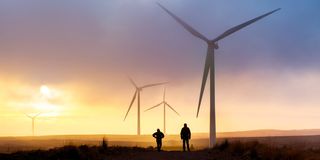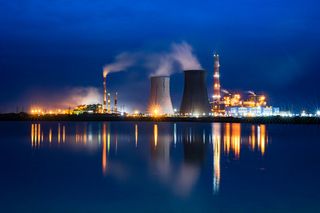Wind turbines: Pros and cons of using this renewable energy source in your project
The effective installation of wind turbines requires careful assessment

More and more homeowners are keeping renewable energy at the forefront their mind, tempted by the prospect of generating free, clean energy.
Most discussions about self-generating power focus on solar panels and air and ground source heat pumps, but homeowners may want consider the pros and cons of wind turbines on their property.
Homebuilding and Renovating spoke to energy and sustainability expert William Hobbs at UK leading trade matching site MyJobQuote.co.uk and Ed Whitworth, Head of Energy Performance at business services firm Bionic, about the pros and cons of wind turbines.
Wind turbine pros and cons
It’s important to assess whether a domestic wind turbine will meet your needs more effectively than other renewable energy sources before investing in the technology.
The cost-effective installation of wind turbines is subject to a host of factors, including planning permission, how much space you have, your property's location, local wind speed, geographical factors, the aesthetics, maintenance, and how the electricity will be stored.
William Hobbs, from MyJobQuote.co.uk, says: “Often solar panels are a better option. To be sure, it’s best to get a survey carried out first. This will need to be done over a period of time to effectively calculate whether there’s sufficient wind.”
If your property is unsuitable for wind turbines but you still wish to harness the benefits of wind power, you may want to consider adaptive renewable energy models that reduce electricity rates when it’s windy, such as Octopus Energy’s ‘Fan Club’.
Customers get notified when the wind speed at their local turbine is at the threshold where they can get 50% off. Many customers choose to shift their energy-intensive chores like putting the washing machine on to this time to make the most of these local green savings.

William is an expert in sustainability and energy. Having previously worked as an electrician, William has expertise in the electric field. In recent years, William has moved on to sustainability and energy consultancy as well as providing his advice and expertise for MyJobQuote. William's expert tips and comments have been featured in a range of leading press outlets.

Pros
1. Clean energy The most obvious benefit of wind turbines is that wind power is a clean and renewable energy source that produces no air pollutants or greenhouse gas emissions during operation. It significantly reduces our carbon footprint and helps combat climate change by lessening our reliance on fossil fuels like coal, oil, and natural gas, which release harmful pollutants when burned.
2. Energy independence Ed Whitworth, head of energy performance at Bionic, says: "By investing in a wind turbine for your project you can play a small part in the bigger challenge to reduce our dependence on finite and imported fossil fuels, enhancing energy security and reducing vulnerability to geopolitical tensions and price fluctuations associated with oil and gas markets. This could help the UK to achieve greater energy independence and stability."
William Hobbs adds: “If you’re building a home in a rural location where mains gas isn’t available, a turbine can help to reduce your reliance on electricity from the grid and offers more resilience from power cuts during bad weather.”
3. Cost savings Ed Whitworth says that once a wind turbine is installed, the ongoing operational costs are relatively low, mainly involving maintenance and occasional repairs. He adds: “While the initial investment and installation costs are high, the more popular wind power becomes and the advances in technology have led to a drop in the cost of wind energy over the past few years, making it more competitive with traditional fossil fuels."
William Hobbs says that after installation, you could save between 20% and 80% a year on your energy bills and you may be able to sell some of the electricity you generate back to the grid. Depending on the energy tariff you sign up for, you’re likely to earn between 2p and 6p per kWh you export. Electricity companies sometimes offer even better rates if you meet certain criteria.

Ed has a background in maths and economics, along with more than a decade's experience in the B2B sector. He also knows his way around market uncertainty, having managed the UK's largest food and drink wholesaler through unforeseen Brexit inflation before overseeing the uncertainty of the pandemic and unprecedented energy market inflation in three short years at Bionic.
Cons
1. High initial costs "Installing wind turbines and all the associated infrastructure often involve high upfront costs," explains Ed Whitworth. "While the cost of wind energy has decreased over the years, the initial investment can still be a barrier, especially for smaller-scale projects with limited financial resources.”
Smaller turbines generating around 2,000 kWh per year can cost between £2,000-£6,000 while installing a larger unit can see prices upwards of £20,000. Larger models do generate more power – around 9,000 kWh per year, which is the equivalent of powering a factory for a year."
2. Location dependency Wind energy generation is highly dependent on the weather and works best on days with high wind speeds. Not all areas of the country have suitable wind resources for efficient and cost-effective energy production – they won’t work for properties in city centres, for example. This means wind power isn’t a renewable option for all projects.
3. Noise and visual impact Wind turbines can generate noise, especially near residential areas. While technology is improving to produce units with lower noise, there are still concerns about the potential impact on human health and quality of life.
William Hobbs says: “Having a wind turbine attached to your roof could detract from the aesthetic appeal of your home. For instance, if you’re building a traditional character property, a modern-looking turbine could spoil the overall look of the exterior.
FAQs
Is a wind turbine suitable for my project?
Domestic wind turbines need to be fitted in an optimal location, whether that’s on a roof or a standalone mast, and then connected safely to your home, so they can be quite complex to set up, explains William Hobbs.
He adds: “That’s why it’s important to find a knowledgeable installer. But they’re not as easy to find as an electrician or gas engineer. However, looking for an MCS-certified engineer should ensure you get a quality installation. This certification will also enable you to sell excess power to the grid.
“It’s also worth checking for installers that are members of the consumer protection organisation, HEIS.”
If you discover your property is unsuitable for wind turbines but you still wish to harness the benefits of wind power, you may want to consider adaptive renewable energy models that reduce electricity rates when it’s windy, such as Octopus Energy’s ‘Fan Club’.
Get the Homebuilding & Renovating Newsletter
Bring your dream home to life with expert advice, how to guides and design inspiration. Sign up for our newsletter and get two free tickets to a Homebuilding & Renovating Show near you.
Sam is based in Coventry and has been a news reporter for nearly 20 years. His work has featured in the Mirror, The Sun, MailOnline, the Independent, and news outlets throughout the world. As a copywriter, he has written for clients as diverse as Saint-Gobain, Michelin, Halfords Autocentre, Great British Heating, and Irwin Industrial Tools. During the pandemic, he converted a van into a mini-camper and is currently planning to convert his shed into an office and Star Wars shrine.